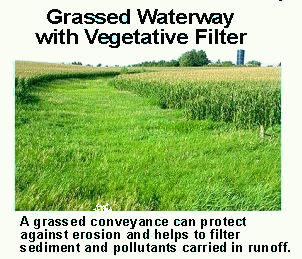Core Principle 4: Conservation Buffers - Grassed Waterway with Vegetative Filter
A grassed waterway is a natural or constructed channel that is shaped or graded to required dimensions and established in suitable vegetation for the stable conveyance of runoff. The primary purposes of a grassed waterway are to convey runoff from terraces, diversions, or other water concentrations without causing erosion or flooding and to improve water quality. The additional benefits of grassed waterways include wildlife habitat, corridors connection, vegetative diversity, noncultivated strips of vegetation, and improved aesthetics.Design considerations for grassed waterways include soil conditions and erodibility, slope, vegetative cover, maintenance, and channel shape. NRCS's National Handbook of Conservation Practices and Engineering Field Handbook are two references that provide guidance in how to plan and design a grassed waterway for its primary purposes. The basic design can be modified to further enhance its performance. For example, providing an additional vegetative width to the grassed waterway allows the waterway to serve as a filter strip/buffer.
As with any filter strip, to be effective in reducing sediment loading from the adjacent field, the runoff must enter a filter strip along the grassed waterway as sheet flow. Vegetation in the grassed waterway must be well established to withstand velocities that it is designed to accommodate. In some areas special measures, such as mulching or flow diversion, are needed to ensure that vegetation has a chance to establish.
![[logo] US EPA](https://www.epa.gov/epafiles/images/logo_epaseal.gif)
